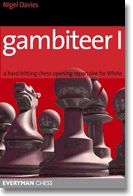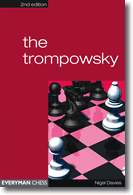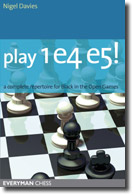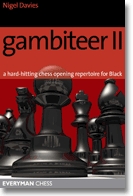Chess Instruction
|

GM Nigel Davies
|
There is no quick fix to mastering chess so Nigel
takes a long-term approach to mentoring, individually tailoring his
guidance to each student's needs and available time. Several students
have studied with Nigel for more than a decade, experiencing
considerable growth in their game during this time. "Chess improvement can be a time consuming job and
prove especially difficult for those with
lives outside the game. For this reason my books, DVDs and
mentoring services are aimed at
enabling players to improve their results as much as possible in the
least amount of time." Learn more about
GM Davies' training services!
|
The
Sicilian Exchange Sacrifice
I recall that some 20 years ago Bent
Larsen, being interviewed by the late Hugh Alexander, opined that if
he were suddenly transported back in time he would easily become World
Champion. The point he was making was not that modern players
are more talented or creative than their predecessors, only that they
have the benefit of knowing more.
Certain ideas and strategies that at one
time had to be created anew, today are merely a question of technique.
Larsen also felt that it would have been easier still if he did not have
Alexander Alekhine to contend with as this great Champion was highly adept
at absorbing new ideas into his chess make-up. I was actually amazed
to see that in the collection of little-known Alekhine annotations, "107
Great Chess Battles", Alekhine understood the potential of the Benko Gambit
some 30 years before Pal Benko! In his annotations to the game van
Scheltinga - Opocensky, Buenos Aires 1939 Alekhine gave the following note
to the position after 1.d4 Nf6 2.c4 g6 3.Nc3 c5 4.d5 d6 5.e4:
A bold and interesting positional
sacrifice. As compensation for the pawn Black will obtain, in the
course of the game: firstly, two open files; secondly, combined pressure
(both vertically and diagonally) on White's b2. The effectiveness of
such pressure is demonstrated, amongst other cases, by the sensational
game Nimzovitsch - Capablanca in the St. Petersburg Tournament of 1914.
Yet the sheer lack of knowledge available
at that time probably left huge gaps in even a player as observant and
hard-working as Alekhine. According to Larsen, Alekhine had probably
never seen Black's positional sacrifice of the exchange on c3 in the
Sicilian Defence. Do you know the one I mean? If not, there was
a good example in game two of the 1993 Short - Kasparov match:
Positional sacrifices of the exchange are
in fact a major feature of modern chess. The reason for this, I think,
is that in the modern openings such as the Sicilian, Gruenfeld and King's
Indian Defences, the position will be closed or semi-closed for many moves.
And without open lines on which to sail into the opposing position, the rook
becomes far less dangerous, at least in the short term.
Returning to Short - Kasparov, look at the
difficulty White will have in activating his Rooks, especially in view of
the weakness of his mutilated Queenside pawns and e4. Black's pieces,
on the other hand, work very effectively within the given pawn structure.
At one time this was thought to be very
good for White, until Black discovered 15...Rxc3! 16.gxf6 Rxe3! 17.Qxe3 Bxf6
18.c3 and now both 18...Rc8 and the immediate 18...b5 give him an excellent
game. A closer examination of this final position reveals that for the
rook Black has a bishop, pawn and magnificently solid position. Just
how should White try to use his extra rook? And would an active plan
not further weaken his position?
Here is a really beautiful example of the
exchange sacrifice on c3 in which the positioning of White's king leads to a
direct attack. If is taken from the game Campora - Yudasin, which was
played in the GMA qualifying tournament in Moscow 1989:
       
       
       
       
       
       
       
       
13...Rxc3! 14.bxc3 Qc7
Unlike the Short-Kasparov game
White's e-pawn is well protected, so Black's only compensation is play
against White's weakened queenside.
Given my earlier remarks about rooks
liking open lines, perhaps 16.exd5 should have been played. Now
Black launches the attack proper.
16...Na4! 17.f4 b4!
       
       
       
       
       
       
       
       
Yudashin prosecutes the attack in
classic style, bringing the maximum number of pieces into the attack
in the minimum amount of time. In his notes in Informator he
pointed out that 17...Nxc3 allows White to defend after 18.Nxc3 Qxc3
19.Bd4 Ba3+ 20.Kb1 and that 17...d4 18.Bxd4 Bxh1 19.Rxh1 would merely
solidify White's defences.
18.cxb4 Bxb4 19.Bd4! 0-0! 20.c3!
Ndc5!
       
       
       
       
       
       
       
       
Capturing on c3 would not be
dangerous for White. Black's next move gives him d5 as an
additional base for operations.
21.Bc2 Ne4! 22.Bxe4 dxe4 23.Rh3
Qc4 24.Kd2!
       
       
       
       
       
       
       
       
White's King has to head for the
hills. Yudashin gave the beautiful variation, 24.Kb1 Bd5 25.cxb4
Qxa2+ 26.Kc1 e3!! 27.Rxe3 Rc8+ followed by 28...Qb2 mate. I will
add only that 25.Rd2 Ba3 also looks unappetizing.
24...Ba5 25.Ra1
If 25.Ke1 then 25...Nb2!
25...Rd8 26.Ke1 Bc6 27.Kf1 Bb5
28.Rb1!
       
       
       
       
       
       
       
       
What makes this game so nice is
White's high-quality defence. Here he meets the threatened
capture on c3 with a counter-sacrifice on b5, and some more fireworks
follow.
28...Bxc3! 29.Rxb5! axb5! 30.Bxc3
After 30.Rxc3 Nxc3 31.Bxc3 Rd3
32.Qb6 h5 (Yudashin), White's position falls apart.
30...Rd3! 31.Rxd3 exd3 32.Bd2
dxe2+ 33.Qxe2 Qd5!
       
       
       
       
       
       
       
       
The smoke has finally cleared with
Black having a clear advantage in the endgame. He has a very
active queen, good knight against bad bishop and White's exposed pawns
to attack.
34.Qg2?!
Immediately going wrong, but this is
hardly surprising in view of the difficulty of White's defence.
Perhaps 34.Kg1 would hang on.
34...Qd3+ 35.Ke1 h6 36.g5 h5
37.Qb7?! Qb1+ 38.Ke2 Qxa2 39.Qa8+
And not 39.Qxb5? Nc3+
39...Kh7 40.Qe4+ g6 41.Qb4 Qc2!
42.Qf8 Nc3+ 0-1
Finally, for those of you who think that I
have been favouring Black, here is an example to redress the balance.
This time it is White who sacrifices the exchange .... on the f6 square!
       
       
       
       
       
       
       
       
The position in the diagram is from
the game Stein - Parma from the USSR - Yugoslavia match in Lvov 1962.
Play continued as follows:
28.Rxf6! gxf6 29.Qf2 Kg8 30.Rf1
       
       
       
       
       
       
       
       
As with Black's sacrifices on c3,
Stein has compensation for his material in Black's shattered pawn
structure and good squares for his pieces. Note the delay in
capturing the pawn on f6 just as Yudashin did not capture on c3.
This pawn makes it difficult for Black to bring his pieces over to
defend.
30...Rde8 31.Nf5 Qd8 32.Qg3
       
       
       
       
       
       
       
       
With the fall of the d6 pawn Black's
position starts to drop apart.
32...Kh8 33.Nxd6 Re7 34.Rxf6 Rxe4
35.Nxf7+ Rxf7 36.Rxf7 Re5
If 36...Qxd5 then 37.Qb8+ decides.
37.c4 Qe8 38.Rf1 Qxa4 39.Qc3 Qe8 40.Bf7 Qf8 41.Rf5
Qd6 42.h3 1-0
GM Davies' Chessville Home
Page
Copyright Nigel Davies, 1998-2008. All rights reserved.

For more from GM Davies,
see also:
The Wit & Wisdom of Nigel Davies
- Part 1 The Wit & Wisdom
of Nigel Davies - Part 2
Index of Annotated Games
|

The
Chessville
Chess Store
Advertisement

Already
Play the
Colle System?Learn to Play it Better! |
The Moment of Zuke:
Critical Positions and
Pivotal Decisions for
Colle System Players |
|

by David Rudel
author of Zuke 'Em
|
|
7 modules written just for
Colle System Players. Over 150 practice problems accompany
lessons written in Rudel's crystal-clear, inimitable style |
|
Thematic Lessons
on game-changing
decisions Colle Players
frequently face
Two Free
Excerpts
Available
|
|
The
Chessville
Weekly
Newsletter

Subscribe
Today -
It's Free!!
The
Chessville
Weekly
Archives

Advertise
with
Chessville!!
Advertise to
thousands
of
chess
fans
for
as little
as $25.
Single insert:
$35
x4 insert:
@ $25 each
From the
Chessville
Chess Store



From the
Chessville
Chess Store
|















